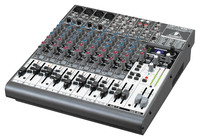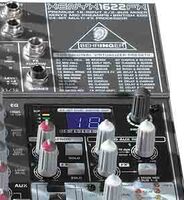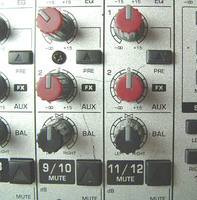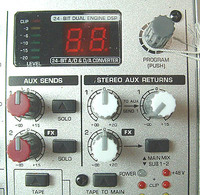![]() Some mixing panels, such as the Behringer UB1622FX-Pro shown here, (and other Behringer models featuring the FX suffix) feature built-in signal processors capable of adding all sorts of echo, reverb, and similar “concert” effects to your live track.
Some mixing panels, such as the Behringer UB1622FX-Pro shown here, (and other Behringer models featuring the FX suffix) feature built-in signal processors capable of adding all sorts of echo, reverb, and similar “concert” effects to your live track.
 These common electronic effects (echo, et al) are referred to as “wet” effects. Think of it as adding a little creamer to your coffee. Most of the signal is the original, but a small percentage of processed audio (such as echo or reverb) is blended over it to achieve a subtle acoustic tweak.
These common electronic effects (echo, et al) are referred to as “wet” effects. Think of it as adding a little creamer to your coffee. Most of the signal is the original, but a small percentage of processed audio (such as echo or reverb) is blended over it to achieve a subtle acoustic tweak.
During filmmaking, we generally, leave this type of manipulation for post-production. What sounded “neat” in the headphones may be a disappointing muck when previewed in a screening room! Best to add those tricks under ideal viewing/listening conditions.
 The other type of signal processing is known as “dry” effects. This means that the entire original signal gets processed, not just a small sampling of it. Examples of dry effects include compression, limiting, and noise gates.
The other type of signal processing is known as “dry” effects. This means that the entire original signal gets processed, not just a small sampling of it. Examples of dry effects include compression, limiting, and noise gates.
It would not achieve anything to apply a dry effect to only part of the incoming (e.g. mic) signal and not all of it. For example, what would be the point of preventing 10% of the overall mic input from exceeding a volume limit, but allowing 90% of the actor’s voice to go into the red? If you are going to keep the actor from shouting his way into distortion, then you would want to apply that control to his entire mic.
Compression squishes the volume range of a signal in order to even out the difference between loud sounds and weaker sounds.
Limiters prevent loud sounds from getting out of hand.
Noise gates mute very low level sounds, but allow stronger signals to pass thru.
Dry effects can be applied to selected mic inputs, or to all of them. It is not always necessary to run all of your mics through a signal processor; only the mics that need automated help to keep them under control. I have found that careful use of dry signal processing can solve a lot of problems commonly associated with live, corporate events.
Using the FX Process on Behringer mixers
 To use the FX Processor on a Behringer mixing panel, first determine whether you want a wet effect or a dry one. Select the effect in the processor module by dialing in a number and pressing the knob to select it. Note that the menu of effects (imprinted near the FX module and/or in the manual) does not list every single variation/intensity of effect; instead the menu only provides the dial number for the first of each family of effects. The remaining consecutive “numbers” (not shown on the guide) would be variations of the first effect.
To use the FX Processor on a Behringer mixing panel, first determine whether you want a wet effect or a dry one. Select the effect in the processor module by dialing in a number and pressing the knob to select it. Note that the menu of effects (imprinted near the FX module and/or in the manual) does not list every single variation/intensity of effect; instead the menu only provides the dial number for the first of each family of effects. The remaining consecutive “numbers” (not shown on the guide) would be variations of the first effect.
The signal flow goes like this. You select and send a copy of the input signal (say, Mic 3) up to the FX processor by opening up the AUX/FX knob on the input module for Mic 3. That sends some of the signal over to the FX module.
The Master AUX/FX SEND knob (on the left, under the FX generator) controls the master level of all of these individual sends. Turn up the Master so that the level meter of the FX processor is bouncing in the middle. Too little raw signal, and it will get hissy. Too much signal, and it will distort. Just get the FX incoming meter to register around midway.
The FX AUX RETURN knob (on the right, under the FX generator) controls how much of the processed signal blends in with your main mix. Open or close the knob to add as much or little of the effect as you deem fit.
 If you are using a wet effect, then allow the original (example, Mic 3) input signal to go to the main mix, and “season” it with a little bit of signal from the FX RETURN knob. This will add a touch of, example, echo from Mic 3 to your overall soundtrack. You would have the main input from Mic 3 assigned to the Main Mix (example, L/R) and the Aux 2 knob (of Mic 3) open so as to also send Mic 3 to the FX Module.
If you are using a wet effect, then allow the original (example, Mic 3) input signal to go to the main mix, and “season” it with a little bit of signal from the FX RETURN knob. This will add a touch of, example, echo from Mic 3 to your overall soundtrack. You would have the main input from Mic 3 assigned to the Main Mix (example, L/R) and the Aux 2 knob (of Mic 3) open so as to also send Mic 3 to the FX Module.
If you are doing DRY processing, the procedure is basically the same except that you have to de-select the original input so it does not go directly to the Main Mix. This can be done by either pressing the Mute button or by de-selecting the track assign button (depending on what model mixing panel you have). You would still want to have the Aux 2 knob open so as to send Mic 3 to the FX module for full processing. From the processor, you would then send it into the Main Mix (or a Submaster, depending on what board you are using).
It sounds harder than it is. Just practice with it a little. Other brands of mixing panel that have integrated FX processing onboard work somewhat similar. That’s the nice thing about using Mixing Panels. If you can “drive” one, you can usually drive anything!
